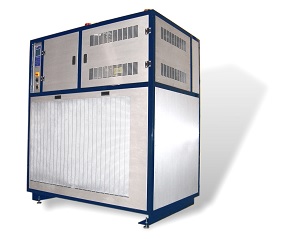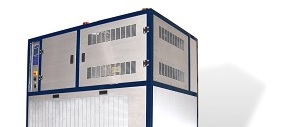 Small but FIT: Compact dehumidification system for plastic mould cabins ensures high productivity at lower operating costs, as networked control enables remote access and fault diagnosis.
Small but FIT: Compact dehumidification system for plastic mould cabins ensures high productivity at lower operating costs, as networked control enables remote access and fault diagnosis.
Press releases from “Fakuma” shows; In order to arrange own production processes more economical, manufacturer of plastic mouldings search for ever new ways of reducing the required cycle time. While doing so, a popular starting point is the cooling time, because it normally takes one third of the time. If, however, the chilled water temperature is simply reduced for this purpose, product quality will decrease due to increased condensation on the mould surface.
One possibility of preventing formation of condensation water also with water temperatures of 6°C is the so-called Mould Area Protector (MAP) from the FarragTech GmbH. Due to enshrouding the mould cabins and their supply with dehumidified air, productivity can be significantly increased. So that also smaller cabins can be effectively dehumidified, the Austrian company has extended its portfolio by the size XS. As of 2019, this is equipped as standard with a revised version of the previous microprocessor control – the FIT Controller. It has numerous connectivity options which allow mobile access to the system, for instance, as well as via a control panel with touch function for the first time. The new MAP XS is presented for the first time on this year’s Fakuma trade fair.
 “A chilled water temperature of 6°C is optimal for the cooling of moulding processes in the plastics industry,” explains Aaron Farrag (left photo), Managing Director of the FarragTech GmbH. On the one hand, this is due to the fact that temperature differences of 1 K cause a change in productivity by 1 percent so that low temperatures directly translate into a production increase. If the temperature falls below 6°C, however, the addition of antifreeze agents will be inevitable. As a result, however, water characteristics will be negatively affected with regard to conductivity. “However, those who only change the chilled water temperature, will be quickly confronted with a nasty surprise,” Farrag continues. “Because the temperature difference between the chilled tool mould and the ambient air results in the fact that condensed water can form on the mould surface.” This is exactly the case if the ambient air has a higher dew point than the temperature in the tool mould. In turn, however, condensation water impairs the quality of products – for instance, due to a modified surface – and of the mould – such as by means of disturbing deposits. Here the MAP from FarragTech GmbH comes into play: This is a dehumidification system for moulding tools which are chilled below the dew point of ambient air using cold water.
“A chilled water temperature of 6°C is optimal for the cooling of moulding processes in the plastics industry,” explains Aaron Farrag (left photo), Managing Director of the FarragTech GmbH. On the one hand, this is due to the fact that temperature differences of 1 K cause a change in productivity by 1 percent so that low temperatures directly translate into a production increase. If the temperature falls below 6°C, however, the addition of antifreeze agents will be inevitable. As a result, however, water characteristics will be negatively affected with regard to conductivity. “However, those who only change the chilled water temperature, will be quickly confronted with a nasty surprise,” Farrag continues. “Because the temperature difference between the chilled tool mould and the ambient air results in the fact that condensed water can form on the mould surface.” This is exactly the case if the ambient air has a higher dew point than the temperature in the tool mould. In turn, however, condensation water impairs the quality of products – for instance, due to a modified surface – and of the mould – such as by means of disturbing deposits. Here the MAP from FarragTech GmbH comes into play: This is a dehumidification system for moulding tools which are chilled below the dew point of ambient air using cold water.
Effective air dehumidification due to enshrouding the mould cabin
 The principle is very simple: The MAP supplies the mould cabin, which is enshrouded from the environment for this purpose, with dehumidified air. For this, the air flows through four stations beforehand in order to achieve the desired condition: At first, ambient air is sucked through a filter. Then it is passed on into a water-cooled heat exchanger and, in a third step, chilled down to 3°C via the heat exchanger of the integrated refrigeration system. As the cold air separates the liquid, the water can be collected in a trough. Afterwards, the air in the condenser is heated up to 25°C so that it can again absorb moisture and blown into the enshrouding. Compared to air conditioning of complete plants, the MAP is thus the alternative saving more operating costs.
The principle is very simple: The MAP supplies the mould cabin, which is enshrouded from the environment for this purpose, with dehumidified air. For this, the air flows through four stations beforehand in order to achieve the desired condition: At first, ambient air is sucked through a filter. Then it is passed on into a water-cooled heat exchanger and, in a third step, chilled down to 3°C via the heat exchanger of the integrated refrigeration system. As the cold air separates the liquid, the water can be collected in a trough. Afterwards, the air in the condenser is heated up to 25°C so that it can again absorb moisture and blown into the enshrouding. Compared to air conditioning of complete plants, the MAP is thus the alternative saving more operating costs.
“As the cabins normally have different dimensions, the MAP is available in different sizes from S to XL,” argues Farrag. “For particularly small mould cabins, we have now additionally extended our portfolio by the size XS.” By means of this model, also small enshroudings can now be supplied with dry air, because in contrast to larger devices, both the operating costs for chilled water and power and investment costs become considerably lower.
Easy to operate via touch screen by means of FIT Controller
Additionally, as of 2019, the new size will be equipped with a revised version of the so-called FIT Controller. Trade visitors can already test the new version of the controller: Here it will be integrated in a CARD device. The controller, which is used in all FarragTech devices, serves to control, monitor and link the MAP. All parameters which are required for these tasks will be set by FarragTech during commissioning – special requests are also realizable. “So it not necessary to carry out manual settings – the MAP will start at the push of a button via the foil keyboard,” says Farrag. In addition, the device can be accessed by means of a Web client, regardless of where the user is located. In order to prevent unauthorized persons from changing settings directly on the MAP or via the IP address, all accesses are password protected ex factory. If required, several authorization levels can be set up for this.
During the process, the controller monitors relevant data and parameters and sends them to a connected storage medium or to a connected internal system via ModbusRTU or ModbusTCP. If the device reports any irregularities, this will be displayed, as of 2019, on the new, user-friendly touch display so that error causes can be quickly determined and removed by means of the recorded values. For a trouble-free operation as possible, FarragTech as well as its national and international representations will therefore support their clients not only with the design and commissioning, but also with the error analysis.
The new MAP XS as well as the revised FIT controller will be presented during a live application on this year’s Fakuma. Furthermore, apart from tried and tested products with numerous innovations, loaders and special solutions will also be shown. For queries, the managing director Aaron Farrag and his team will be glad to be available to you at the fair booth A3-3205.
FarragTech was originally founded in 1991 as FASTI by Rainer Farrag, the inventor of the first compressed air dryer, and by Bernhard Stipsits. After both managing directors decided to go separate ways in 2002, Rainer Farrag founded the FarragTech GmbH effective from 1st June 2005. The company specialises in peripheral devices for further processing of plastic resin, increasing the quality of products as well as the productivity of the processing machines. The portfolio of the manufacturer includes resin dryers which are a further development of the compressed air dryer invented by Rainer Farrag, as well as systems for internal mould cooling, various loader and atmospheric air drying devices for mould area protection, of which were also developed by FarragTech. The company currently employs eight staff in its Wolfurt headquarters in Austria. Production takes place in Slovenia, with marketing carried out worldwide. For more information:
info@farragtech.com
About “Farrag Tech”
FarragTech was originally founded in 1991 as FASTI by Rainer Farrag, the inventor of the first compressed air dryer, and by Bernhard Stipsits. After both managing directors decided to go separate ways in 2002, Rainer Farrag founded the FarragTech GmbH effective from 1st June 2005. The company specialises in peripheral devices for further processing of plastic resin, increasing the quality of products as well as the productivity of the processing machines. The portfolio of the manufacturer includes resin dryers which are a further development of the compressed air dryer invented by Rainer Farrag, as well as systems for internal mould cooling, various loader and atmospheric air drying devices for mould area protection, of which were also developed by FarragTech. The company currently employs eight staff in its Wolfurt headquarters in Austria. Production takes place in Slovenia, with marketing carried out worldwide.
Main “SOURCE”
***********************
Keeping an independent media in countries that impose limitations with a paid subscription, will help to support the humankind’s freedom. If you believe it please act by clicking “HERE“, or:













